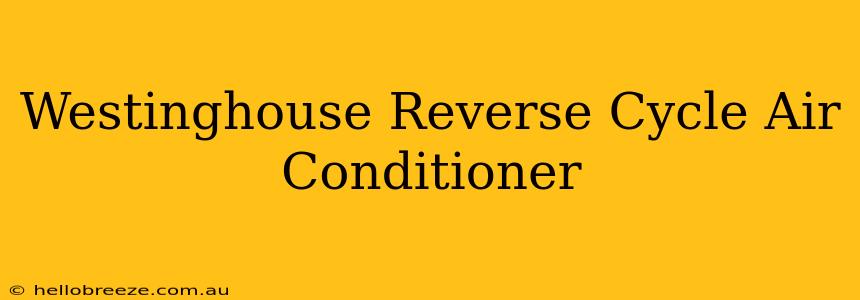Choosing the right air conditioner can significantly impact your comfort and energy bills. Westinghouse reverse cycle air conditioners offer a compelling solution, providing both heating and cooling in one efficient unit. This comprehensive guide dives deep into the features, benefits, and considerations when choosing a Westinghouse reverse cycle air conditioner.
Understanding Reverse Cycle Technology
Before we delve into Westinghouse specifics, let's clarify what a reverse cycle air conditioner actually is. Unlike traditional systems that only cool, reverse cycle (also known as heat pump) systems use a refrigerant to both cool and heat your home. In cooling mode, it absorbs heat from inside and releases it outside. In heating mode, the process reverses, drawing heat from the outside air and transferring it inside. This makes them incredibly energy-efficient, especially in climates with moderate winters.
Key Advantages of Reverse Cycle Systems:
- Energy Efficiency: Often more energy-efficient than traditional electric heating systems.
- All-Year Comfort: Provides both heating and cooling, eliminating the need for separate systems.
- Cost Savings: Lower running costs compared to individual heating and cooling units, especially in the long run.
- Environmentally Friendly: Reduced carbon footprint due to improved energy efficiency.
Westinghouse Reverse Cycle Air Conditioner Models: A Closer Look
Westinghouse offers a range of reverse cycle air conditioners to suit diverse needs and budgets. Their models typically feature:
- Variable Speed Technology: Many models offer variable speed compressors and fans, allowing for precise temperature control and optimized energy use.
- Smart Features: Some advanced models incorporate smart technology, enabling remote control via smartphone apps.
- Quiet Operation: Westinghouse prioritizes quiet operation, ensuring minimal disruption to your home.
- Durable Construction: Built to withstand Australian conditions, ensuring lasting performance.
- Different BTU ratings: You can find units with a range of BTU ratings, allowing for optimal cooling and heating for different sized rooms or entire houses.
Choosing the Right Westinghouse Model:
Selecting the correct size and features is critical. Consider these factors:
- Room Size: Ensure the BTU rating matches the square footage of the area to be cooled or heated.
- Climate: Your local climate will influence the required heating and cooling capacity.
- Energy Efficiency Rating: Look for models with high energy efficiency ratings (like SEER and HSPF) for better long-term cost savings.
- Features: Decide which features are essential (smart capabilities, quiet operation, specific cooling/heating modes) and which are optional.
- Budget: Westinghouse offers a range of models at different price points to suit various budgets.
Installation and Maintenance
Proper installation is vital for optimal performance and efficiency. It's strongly recommended to engage a qualified HVAC technician for installation and regular maintenance. Regular maintenance includes:
- Filter Changes: Regularly changing air filters ensures efficient airflow and prevents dust build-up.
- Coil Cleaning: Cleaning the condenser coils improves efficiency and longevity.
- Annual Inspections: Professional inspections identify potential issues early, preventing costly repairs.
Conclusion: Your Path to Comfortable Living
Westinghouse reverse cycle air conditioners offer a reliable and energy-efficient solution for year-round climate control. By considering your needs, budget, and the factors outlined above, you can choose the perfect Westinghouse model to enhance your home comfort and significantly reduce your energy costs. Remember to consult with a qualified HVAC professional to ensure correct sizing and installation for optimal performance.

